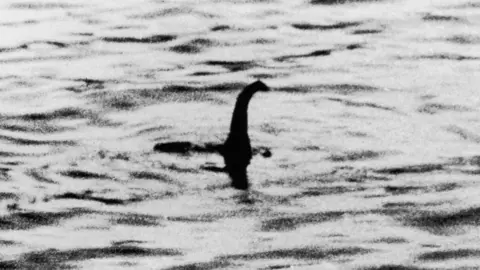Plan for biggest Nessie search in more than 50 years
 Getty Images
Getty ImagesWhat has been described as the biggest search for the Loch Ness Monster since the early 1970s is due to be held later this month.
Drones fitted with infrared cameras are to be flown over the loch, and a hydrophone is to be used to detect unusual underwater sounds.
Organisers said volunteers would also look for possible signs of a creature from safe vantage points on land.
The search is to be held on 26 and 27 August.
The Loch Ness Centre in Drumnadrochit and a volunteer research team called Loch Ness Exploration are organising the effort.
They said it would be the biggest search for the monster since the Loch Ness Investigation Bureau studied the loch in 1972.
The bureau was set up in the 1960s to uncover the existence of a large beast in the waters.
People can pay for trips on the loch during this month's search.
Alan McKenna, of Loch Ness Exploration, said: "It's our hope to inspire a new generation of Loch Ness enthusiasts and by joining this large scale surface watch, you'll have a real opportunity to personally contribute towards this fascinating mystery that has captivated so many people from around the world."
Paul Nixon, general manager of the Loch Ness Centre, said the search would involve technology not previously used before.
A spokeswoman added: "Volunteers' safety is of course a priority during the quest.
"All viewing points are on land, and volunteers will be briefed by organisers each morning on suitable viewing points to ensure their safety."
 Getty Images
Getty ImagesIn 2019, scientists said the creatures behind repeated sightings of the fabled Loch Ness Monster may be giant eels.
Researchers from New Zealand tried to catalogue all living species in the loch by extracting DNA from water samples.
Following analysis, the scientists ruled out the presence of large animals said to be behind reports of a monster.
No evidence of a prehistoric marine reptile called a plesiosaur or a large fish such as a sturgeon were found.
In April 1933, hotel manageress Aldie Mackay told of seeing a whale-like creature and the loch's water "cascading and churning".
The Inverness Courier newspaper reported the sighting and the editor at the time, Evan Barron, suggested the beast be described as a "monster" - kick-starting the modern myth of Nessie.
In an interview years later, Mrs Mackay said she had seen something "black, wet, with the water rolling off it" moving in a circle. She described it as a "beast" to her husband.
The legend dates back to the Middle Ages when Irish monk St Columba is said to have encountered a creature in the Ness, a river that flows from Loch Ness.
